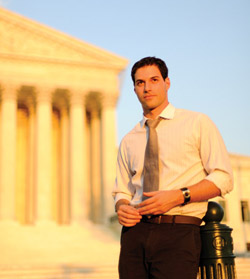This 3L Gave Himself and His Readers an Alternate View of the 'General Republic'

Photo by Cameron Davidson
My name is Mike Sacks. I am a third-year law student at Georgetown interested in legal journalism and the intersection of law and politics. This semester, I have no morning classes. As such, I will be taking advantage of living only minutes from the Supreme Court to pursue a rather unorthodox extracurricular activity: reporting from the court as the first one in line at 1 First St.
I wrote that in a fit of inspiration late one night last December. And just like that, I became the author of the blog First One @ One First. That is, I am a reporter who, for a semester of law school, took his view of the U.S. Supreme Court from the public line that forms in the early morning hours on the days of important oral arguments. I went outside to explore the opinions of those who cared enough about an issue to stand there in a freezing predawn to assure themselves a seat to hear a newsworthy case. That was the theory, at least.
From my first morning on Jan. 11 until my final overnight on June 27, I witnessed relationships and communities being formed among men and women whose personal engagement with the American system of government transcended their political differences.
I wasn’t always first in line, despite my aspirational title (I was six for 10, for the record), but whether I was first in line, second, third, fifth or 34th, I found all around me new friends cutting through the cold by the warmth of each other’s company.
In January, there were Jim and Meade Klingensmith, the toweringly tall father and son from Pittsburgh who sauntered into line on every argument morning for the entire two-week sitting. Meade was a sophomore at Oberlin College pursuing an independent study in which he was observing the court in action and then predicting its decision in each case. Jim, Meade’s dad, had a big grin each morning, thrilled to have these mornings to bond with his boy, even if it meant they had to wake up at 4 a.m. for half the week to do so.
In February, scores of black firefighters from Chicago came out to see justice served in Lewis v. City of Chicago, a disparate-impact case that was decided in their favor by a unanimous vote several months later. Among the attendees was Jim Winbush, a retired firefighter who founded the African American Firefighter’s League of Chicago in 1968 to fight for greater equality in a newly integrated fire department charged with putting out the fires that had raged through the city during that summer’s race riots. Arriving in line before dawn, Win bush talked until the sun came up about his more color ful days on the job, attracting an ever-expanding crowd of amused listeners.
With March came McDonald v. City of Chicago, the court’s Second Amendment sequel to 2008’s District of Columbia v. Heller; which established in federal jurisdictions the individual right to keep and bear arms for purposes of self-defense. McDonald asked whether Heller should be applied to state and local gun control efforts, and brought more talk about the 14th Amendment’s privileges or immunities clause than you’d find in an entire semester’s constitutional law seminar. And those leading the discussion weren’t lawyers or law students; they were chemists from Malibu, Calif., and military vets from Connecticut and Texas.
For some reason, late April seemed no warmer than early March. And outside the court on the eve of Christian Legal Society v. Martinez, I sat surrounded—with students from CLS chapters across the country on one side of me and a same-sex couple on the other, all huddling together to keep each other from freezing. The question to be considered by the court the next morning was whether the University of California’s Hastings College of the Law violated First Amendment rights of association and free exercise of religion by refusing to recognize and fund CLS as an official campus organization because of its policy barring gays and lesbians from serving as officers.
To hear oral arguments on these issues was our reason to be there in the first place, and there were turned heads and giddy giggles from even the most grizzled of my cohorts as they climbed the steps to enter the building. It was hard not to be awestruck walking the Great Hall with the busts of every chief justice staring at you through their marble, iris-less eyes, as you make your way toward the courtroom. And there’s nothing quite like the payoff of taking your seat inside the courtroom, between the massive stone pillars, after waiting all night to get there. The 30 minutes between that moment and the emergence of the justices to the marshal’s “Oyez, oyez, oyez” are so filled with a sense of anticipation that the hours outside seem like seconds by comparison.
But as inspiring as that is, there were nights on the line when we could be just as awed by the way the line itself could connect even the most remote corners of the body politic.
Follow the link to continue reading “By Dawn’s Light” in the October ABA Journal.



